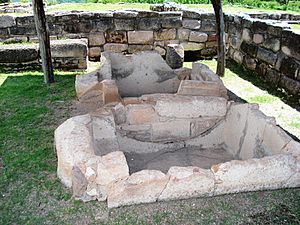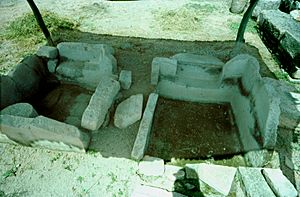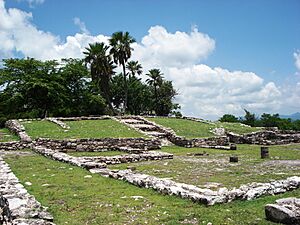Cuetlajuchitlán facts for kids
Quick facts for kids Mezcala Culture – Archaeological Site |
||
| Name: | Cuetlajuchitlán archaeological site | |
| Type | Archeology | |
| Location | Paso de Morelos, municipality of Huitzuco de los Figueroa, Morelos |
|
| Region | Mesoamerica (México) | |
| Coordinates | 18°12′11″N 99°12′27″W / 18.203°N 99.2075°W | |
| Culture | Cuitlatec - Mezcala | |
| Language | Cuitlateco | |
| Chronology | 800 a.C. – 300 d.C. | |
| Period | Mesoamerican Late Preclassical | |
| INAH Web Page | Conaculta page Cuetlajuchitlán (Los Querendes) | |
Cuetlajuchitlán is an ancient city site in Mexico. It is found in the state of Guerrero, near Paso Morelos. This amazing place was discovered by accident in 1991. Workers were building a highway from Cuernavaca to Acapulco. The highway now goes under the site through a tunnel.
Cuetlajuchitlán was a major city long ago. It was important for the Mezcala culture people. They lived along the Balsas River. The city grew from about 800 BCE to 300 CE. It is special because it is very old. Its buildings show smart ways to store things and manage water. They also built with cool stone columns.
Contents
What Does the Name Mean?
The name Cuetlajuchitlán comes from the Nahuatl language. It means "Place of red flowers" or "Withered place."
Some people think the "red flower" might be the Poinsettia. This plant grows naturally in the area.
Exploring the Ancient City
The Cuetlajuchitlán site is very large, about 35 hectares. But only a small part, about two hectares, has been explored. The uncovered parts are on a limestone hill. This is where people lived during the Late Preclassical period.
Cuetlajuchitlán grew in three main stages. This happened over about 900 years.
First Builders (800-600 BCE)
Not many old things were found from the first stage. This stage had limestone rock walls. These walls made flat areas for houses. Some small statues and pots were found. These items show that Cuetlajuchitlán was a small village back then. It might have been linked to larger Olmec-related groups. Or, people might have settled here around 600 BCE. This was when other Olmec sites were becoming less important.
A City Grows (200 BCE - 200 CE)
Cuetlajuchitlán became a busy city between 200 BCE and 200 CE. Many ceramic objects were found from this time. They show the city was doing well. Sculptures carved from stone were also found. During this time, the city's buildings really started to develop. People used carved limestone blocks and cylinders. They made columns and walls that were very well built.
The City's Final Years (Around 300 CE)
Building continued in this stage. People reused materials from older buildings. This included stone blocks and grinding stones called Metates. The limestone walls look like the style of the Mezcala culture. Around 300 CE, Cuetlajuchitlán started to decline. Eventually, people left the city.
Life in Cuetlajuchitlán
The city had a complex layout. It had stone streets, big platforms, and open areas. Some spaces were rooms, storage areas, or workshops. It seems that important people lived here. They likely managed city activities and led ceremonies.
The site has several important areas. These include two ceremonial places. There are also three housing areas. These were likely for important people and skilled workers. The most important buildings are in two explored areas:
Ceremonial Enclosure 1
This is the main building at the site. It is a rectangle, about 28 meters long and 18 meters wide. Its large platform and walls were made from limestone blocks. Two pink stone tubs were found here. They were carved from a single stone. These tubs were probably used for special baths. Near this main platform is a Temazcal. This was an ancient steam bath.
Ceremonial Enclosure 2
This area is next to Ceremonial Enclosure 1. It has two tubs that were probably used before this enclosure was built. Materials from older buildings were reused here. This area was also used for carving and storing pink stone blocks. These blocks were then used for new buildings.
City Structures
Residential Housing Complex
These were homes for the city's leaders. They are on the northern, southern, and western sides of the hill. They had streets that connected to platforms. The pink limestone rooms had sunken patios. They also had drainage systems, water tanks, and small storage areas.
Complex 8
This complex is about 200 meters from the main explored area. It is a large square area. It has platforms with houses around it. These houses also had water tanks and a water channel. In the center is a big platform. This was likely the home of the person who ruled Cuetlajuchitlán.
Storage Areas
Many parts of the site have buildings that look like storage areas. They might have held grain, food, or products. These underground storage rooms had limestone walls and floors. Many broken ceramic pots were found in these areas.
How to Visit Cuetlajuchitlán
The site is at kilometer 188 on the Cuernavaca - Acapulco highway. It is 3 kilometers southeast of Paso Morelos, in Huitzuco de los Figueroa. You can visit the site from Tuesday to Sunday. It is open from 10:00 AM to 5:00 PM.
Images for kids
See also
 In Spanish: Cuetlajuchitlán para niños
In Spanish: Cuetlajuchitlán para niños













